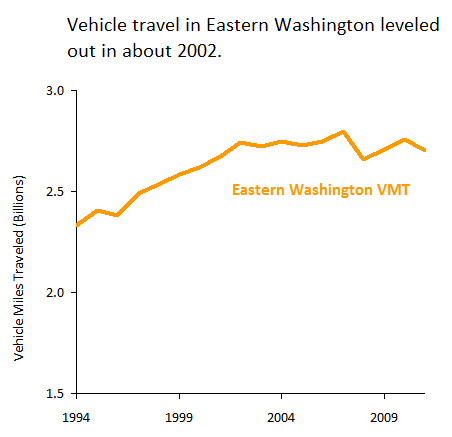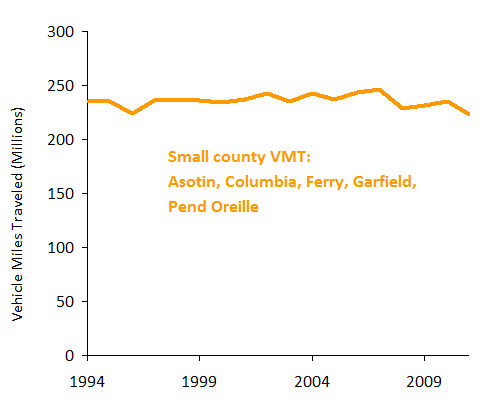I’ve been following flat-lining traffic trends for a while now—and much of my focus has been in Cascadia’s big cities and major metro areas. But the trends are equally clear in smaller cities and rural areas.
Take, for example, this chart of traffic in Eastern Washington, with the latest data from WSDOT’s Annual Traffic Report:
 As you can see, traffic volumes in the eastern third of Washington rose fairly steadily through about 2002. Since then, they’ve been stuck on a bumpy plateau.
As you can see, traffic volumes in the eastern third of Washington rose fairly steadily through about 2002. Since then, they’ve been stuck on a bumpy plateau.
About 45 percent of the traffic in the chart above came from Spokane County, which is dominated by a mid-sized city and its suburbs. But what about the smaller counties? Is their traffic on the upswing?
To find out, I took a look at the five smallest counties in Eastern Washington, ranked by population. As a caveat: because the sample is pretty small, I don’t know how much stock to put in the numbers—but it’s an even more surprising trend than for the region as a whole:
Yep, that’s right: according to WSDOT, small counties in Eastern Washington have seen no net traffic growth since 1994. Yes, there have been temporary blips up and down, and vehicle travel may have dipped a bit since 2008. But the basic trend is flat. And in case you’re wondering, these counties have actually been growing: the census says that population in those five counties grew by about 12 percent over the period covered in that chart.
Clearly, the flat-lining of traffic isn’t just affecting big cities; it’s not simply a result of big urban highways filling up to capacity. Instead, the trends are much more widespread. It’s good news in some very important ways…but it’s also news that doesn’t seem to have filtered down into the official thinking about big highway expansions.









Southender
Never fear, WSDOT is still valiantly fighting this trend!
http://www.wsdot.wa.gov/Projects/US395/NorthSpokaneCorridor/
Their new motto should be, “Induce or die!”
Clark Williams-Derry
I know, I know. That’s one reason I made this chart.
For the life of me, I can’t figure out how WSDOT thinks it’s going to pay for all of the massive projects it’s planning…
TVDinner
One of the many things that drives me crazy about the North/South freeway is they cleared out an entire neighborhood to put in the interchange at I-90. When I asked some people from WSDOT at the Spokane Bike Expo (they were touting the “People of the Sun” bike trail they had to put in to get funding) when that part of the freeway is expected to be done they said blithely, “Oh, about 20 years.”
Twenty years?!?! They wiped an entire neighborhood off the map, leaving a blighted space in its wake. And I don’t even think they have funding for that portion of the freeway yet. GAH.
Barry Saxifrage
Great article and charts, thanks.
Amazing what happens when the price of a carbon fuel like oil goes up. Oil averaged around $40/barrel in 2005 and is closer to $90/barrel now. That rise is equal to a carbon tax of ~$100/tCO2.
Sure enough, people are buying less gas. According to stats from US EIA that I’m working with right now, oil use per person in USA has declined 17% since 2005.
As a nation, USA has cut annual CO2 from oil by 330 MtCO2 since 2005. That is equal shutting down all CO2 emissions from all sources in the combined region of:
* BC
* Washington
* Oregon
* Idaho
* Nevada
* Montana
* and Wyoming